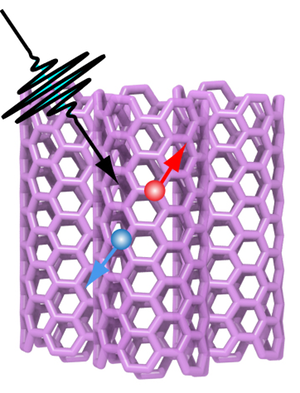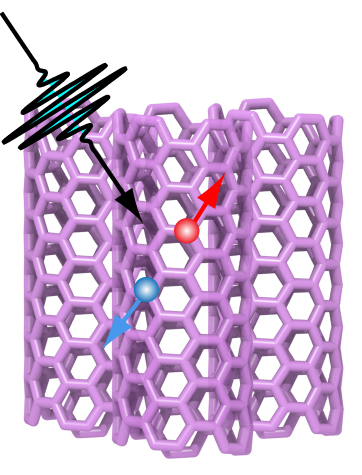Nanotube Bundles Show Promise for Solar Cells
Solar electricity generation may someday be cheaper with so-called thin-film photovoltaics than with conventional materials, but the thin-film systems are currently much less efficient. Researchers publishing in Physical Review Letters have now shown that bundles of carbon nanotubes—cylinders of pure carbon—have the potential to dramatically increase that efficiency. Using high-speed spectroscopy, they found that the bundles can perform the two main required functions—generating charged-particle pairs and allowing the pairs to separate. Today’s thin-film solar cells, which are layered structures, can’t perform both functions in a single material, which leads to reduced efficiency. The team is hopeful that their work will lead to practical, nanotube-based, thin-film solar cells with high efficiency.
Thin-film photovoltaic structures are cheaper, lighter, and more flexible than the materials found in conventional solar cells, such as silicon. They generate electricity by first absorbing a photon from the sun and generating an exciton—an electron and a positively-charged hole bound together in a mutual orbit. Then, to create current, the electron and hole must be separated in the brief time before the two particles join together and are absorbed back into the material. In a solar cell, the exciton must rapidly drift to another layer in the device where the charge separation occurs, but the fast “reabsorption” of excitons before charge separation is the leading cause of low efficiency.
To solve this problem, researchers have been searching for a material that can both generate the exciton and separate the charges. Inspired by a two-decade-old theory [1], a team led by Jared Crochet of the Los Alamos National Laboratory in New Mexico looked into carbon nanotube bundles, which several other research groups have been studying for other purposes. With techniques developed by others, the team used an ultracentrifuge to collect carbon nanotubes into bundles segregated by diameter and type of twist. They chose bundles with a diameter and twist that led to a strong absorption of light at a wavelength of about 570 nanometers, which is ideal for sunlight. “This separation method is really opening up the field,” says Crochet. “Initially all we had with nanotubes was black soot that was not useful.”
Crochet and his colleagues used equipment that could reveal the spectrum of a sample much faster than conventional spectrometers. They exposed two different types of samples to a brief flash of laser light before recording spectra every few tens of femtoseconds. For samples of both nonbundled and bundled nanotubes, they saw a spectrum characteristic of exciton creation, but the bundled nanotube spectra contained an additional peak that signaled the production of free charge carriers.
Crochet says that while the excitons produced in single nanotubes were quickly reabsorbed back into the material, the excitons produced in the bundles skipped across to an interface between tubes, where the charge separation occurred. Having identical tubes in the bundle was essential to the process, the team found. And the tube interface provides enough of a jolt to an exciton to cause it to separate. “If you have nothing there next to the tube, they have no reason to break apart,” explains Crochet.
Crochet’s team is now working on producing testable photovoltaic devices out of their tube bundles. If the next phase of their work goes well, they envision photovoltaics that can be sprayed or drawn onto a substrate and can convert light to electricity with high efficiency. Further, they have found that the bundles don’t break down in ultraviolet light the way other organic, thin-film photovoltaics do.
Considerable work remains to fully understand this process of high-efficiency exciton dissociation in nanotube bundles, says Tony Heinz of Columbia University in New York. “This whole subject is not as well understood as one might like,” he says, but he thinks the work looks promising. “Carbon nanotubes are incredibly stable, and inherently they’re very cheap.”
–Michael Wofsey
Michael Wofsey is a desalination physicist and engineer with a Department of Energy services contractor in Golden, Colorado.
References
- T. Ogawa and T. Takagahara, “Optical absorption and Sommerfeld factors of one-dimensional semiconductors: An exact treatment of excitonic effects,” Phys. Rev. B 44, 8138 (1991)





